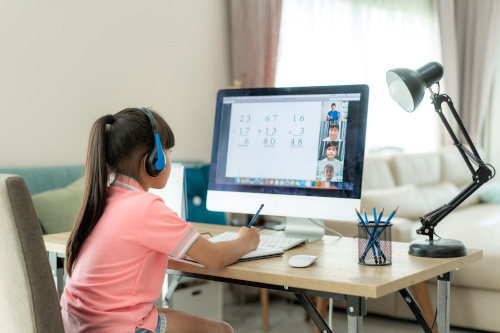As we settle into another academic year filled with uncertainty due to the pandemic, educators are taking a deeper look into what can be learned from the tumult of the last two years. Schools around the world were forced to quickly pivot to virtual learning and many have just recently returned to a traditional, in-person model.
Many parents still want an online option, but critics of online learning have questioned whether students really progressed academically without in-person supervision. The question on everyone’s mind: “Do students learn when you don’t see it?”
The short answer is yes, and it becomes abundantly clear why–once we update our mindset around what education can and should look like, and how we measure its success. Online learning provides access to a wealth of data that educators can use to personalize learning for students. Once educators and districts understand the unique advantages of online teaching and learning, they can update their approach to take advantage of the best of both worlds.
Learning from learner behavior
New possibilities are unlocked in a virtual environment when we recognize the power of data. Today’s online learning platforms generate a lot of data that would be either impossible or too time-consuming to collect in person. Where traditional education models measure face time with students and pop quizzes, online teaching tools have evolved to allow educators to go deeper.
With the right tools and training, educators can more accurately and easily track homework completion rates, time logged into class or office hours, what percentage of an assignment a student has completed, and assessment scores. This comprehensive picture of student activity, effort, and outcomes helps teachers better understand where each student is and how they can tailor their efforts to help them progress to the next level.
Personalizing education for each student
Online learning has the ability to quickly and effectively bring personalized learning directly into the classroom. The abundance of data available on each student’s learning journey also enables far greater personalization in the pace and context of the curriculum. If a student demonstrates mastery of a particular skill, they can move on to more challenging material as soon as they’re ready. If a student is falling behind, the teacher can provide extra assistance to help them get up to speed. One student could be working on learning what a fraction is while another is working on how to add them. All students are working on math at the same time, but each is learning at their own pace.
The accessibility offered by online learning means that students aren’t left behind, struggling to keep up with the rest of the class, or getting bored when they’re ready to move on. Being able to personalize lesson plans means everyone has the chance to learn at the speed that is right for them.
Should you flip the script, or adjust it?
Online education doesn’t need to be all or nothing. Hybrid classrooms combine digital and physical environments, allowing educators to focus on guiding discussions and helping students develop their critical thinking and problem-solving skills.
A hybrid model can instill newfound confidence and independence among students in and out of class. Research has shown when students do background reading and independent work on their own, it satisfies their need for autonomy and they come to class better prepared to have higher-level conversations with their peers. Educators don’t need to spend limited class time revisiting content for everyone, covering facts, or quizzing students to make sure they did the homework.
Leveraging online learning doesn’t mean discarding traditional education plans. In many ways, online learning tools act as a supplement to multiply the effectiveness of in-person teaching. By analyzing data on how students are doing, educators can expand upon their tried and true lesson plans to see what works, and what doesn’t, to help students perform better and save them time in the long run.
Are you asking the right question?
Some educators may feel that they are giving up control of their classrooms by embracing online learning, but in reality, online learning gives educators the opportunity to get to know their students better and personalize their learning experiences.
The question shouldn’t be “Are students learning when you don’t see it?“ Instead, the question should be, “Are we providing the best learning experience that we can for our students?”
Answer that question, and the opportunities available online become much harder to deny.
- High school students say AI will change the workforce - April 18, 2024
- Motivating students using the Self-Determination Theory - April 17, 2024
- Michigan Virtual’s statewide workgroup releasing AI guidance for K-12 educators - April 17, 2024

